My friend Dave Auldridge, formerly a structural geology student of mine at George Mason University, is now in grad school at the University of Alabama. Dave is working on an interesting project with speleothems: those drippy looking CaCO3 growths that you find in caves, like stalactites and stalagmites. He’s looking at these speleothems in order to determine paleo-climate with oxygen and carbon isotopes. The carbon soot that’s trapped in the speleothems provides a novel mechanism of constraining the age of the different laminations which comprise the feature.
The other day, Dave sent me some neat images from his research, and when I expressed enthusiasm and appreciation, he gave me permission to post them here. All these images are from stalagmite #4 (DSSG-4), DeSoto Caverns, Alabama. The are all imaged with a scanning electron microscope (SEM), which is why there is no color, only texture.
The first image shows a nugget of carbon soot that, according to Dave, is “probably common cane, that fell off an Indian’s torch ~1000 years ago.” The cave where this stalagmite was collected was used as a Native American burying ground. Prior to going into the SEM, the sample has been acid washed, which means that it has enjoyed a 30-second cold 5% HCl dip.
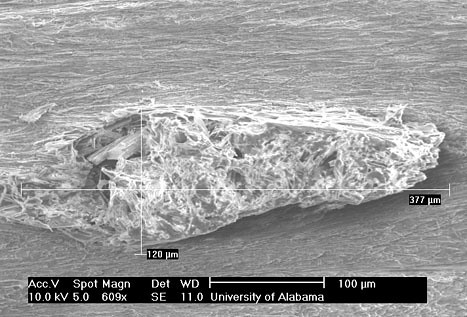
That’s seriously cool: thousand year old Native American torch ash… inside a stalagmite! Dave reports to me that these carbon laminations suddenly stop about the same time Hernando de Soto showed up in the Southeast with his conquistadors. Then the laminations resume once the cave started getting used as a saltpeter mine. Dave tells me that there’s a little bit of silica in these laminations too — which may be from phytoliths in the cane.
This next chunk may be carbon soot, or may not. Dave adds, it “may be a bug, maybe not…” As with the first image, this sample has been acid washed.
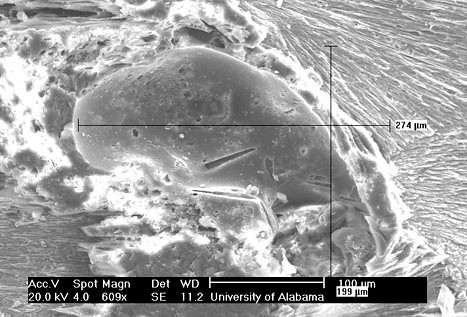
This one shows a coarse spar of calcite, penetrating down into the aragonite. The younging direction of the aragonite is left to right: you can see the bundles branch out in that direction. The sample has been acid washed.
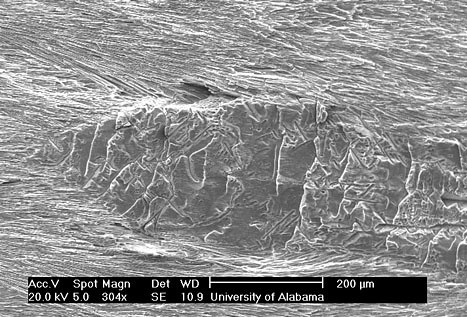
I am reminded of a school of sardines swimming around a whale…
Our penultimate image is looking down on to an up-growing aragonite bundle (inter-fingering of several bundles can be seen). The sample has not been acid washed. Don’t lean too close, or you might scratch your nose!
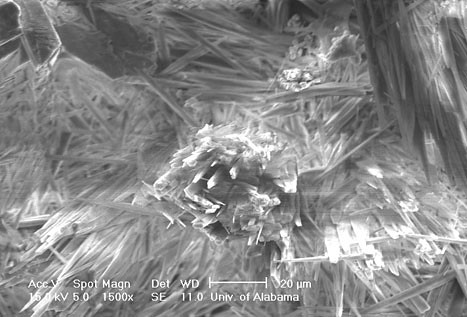
The last (and most beautiful, in my opinion) is of aragonite bundles cut perpendicular to growth laminations. The younging direction is left to right.
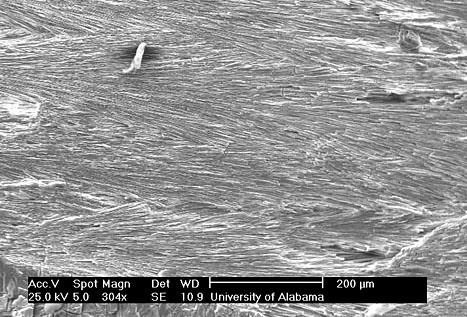
These last two images are incidental to Dave’s research, as no carbon soot can be seen. But he took them and passed them around his research group (and his extended e-mail network of former professors) just as something cool to look at. As he said, “We are geologists, right?” (We like looking at pretty rocks!) As far as he knows, no other speleology research group has cut and imaged a speleothem along a lamination.
Dave’s work used the Central Analytical Facility, which is supported by The University of Alabama.

Nice pics. I’ll have to complement Dave on his pretty samples if I run into him at the alumni dinner in a few weeks.
I guess geology is a small world, as soon as I saw he was at Alabama (and speleothems) I knew who he was working with and doing paleo-climatology.